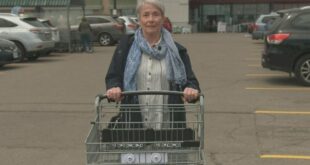A Christmas tree shortage driven in part by climate change means higher prices for real trees.

Tree farm customers Amy and Ram Nathu and their three kids showed up at Red Truck’s tree lot in South Surrey, B.C., ready to pick out the perfect tree to cut down.
They expected to pay about $100 for the tree, but according to Amy, it’s worth it. “A real tree is our number one tradition,” she said. Their daughter, Roxy, 10, refuses to consider an artificial tree.
“You can smell it, and a fake tree isn’t the same. You don’t get to cut it or anything,” said Roxy.
But this season, the hunt for that perfect tree is becoming a bit more difficult. A dwindling number of growers and a severe shortage of conifers — driven in part by climate change — means tree prices are soaring and sellers are shifting tactics, with some companies abandoning online orders, or ending tree sales altogether.

Ikea announced it’s not selling trees at its Canadian stores this holiday season due to the shortage. Full-grown trees are difficult to source at a competitive price in part because heat events and drought killed seedling and adult trees in the Pacific Northwest.
Canada had about 1,360 tree farms in 2021 compared to 2,381 in 2011, meaning approximately 1,000 farms have vanished in the past decade, according to the most recent data from Statistics Canada.
Shirley Brennan, the executive director of the Canadian Christmas Trees Association, based in Hockley, Ont., says Canada has lost more than 8,000 hectares of Christmas tree farms as growers retire or die, with nobody eager to take over the difficult business.
“The people that go into this are the people that have patience, because it’s a labour of love,” said Brennan, explaining that because it takes 10 to 14 years for a newly planted tree to be ready to harvest, tree farmers don’t see a return on those first trees for more than a decade.

A perfect Christmas tree is hard to find and getting more expensive
Cultivated pine trees are getting harder to find and becoming a lot more expensive, which has consumers paying more. Some non-profits say tree sales are becoming a less viable fundraising option.
Climate change a challenge for growers
Larry Whitehead of Red Truck Trees says fewer tree farms and farmers translates into a loss of millions of trees, and climate change isn’t making things any easier. Whitehead says B.C. tree growers have never needed to irrigate in the past, but now, with heat waves and droughts, irrigation is crucial, even for some species of mature conifers.
Whitehead, a director with the B.C. Christmas Tree Association and the Canadian Christmas Tree Association, has grown trees for 15 years. He opened tree sales on Nov. 24 at his cut-your-own lot, where he also sells cut trees.
While you can pick up a so-called Charlie Brown tree there for around $20, a two-metre tree with fuller branches will cost anywhere from $80 to $200 at Red Truck (and most other lots), depending on the variety.
Whitehead says the cost of everything from fuel to pesticides is up.

Tree shortage hits service clubs hard
The hunt to find reasonably priced trees is driving one North Vancouver non-profit to consider a new fundraiser, though they’ve relied on tree lot sales for close to 40 Christmas seasons.
“From a fundraising standpoint, trees are number one,” said Eric Miura, president of the Lynn Valley Lions Club.
Miura said they were only able to order 600 trees from Washington State this year. Far less than the usual 1,200 to 1,600 Noble Fir trees on their tree lot, which is canopied by massive rooted fir.
“Apparently, there’s quite a bit of dead loss,” said Miura. “And stock is dwindling.”
Intense heat events in the summer turn more mature evergreens brown before they can be harvested, he says, noting smaller seedlings can’t survive the high temperatures.
“So we end up with a very small stock of trees to pull from.”
With so few trees to sell, the Lions Club cancelled online sales and delivery this year.
“We’re really disappointed,” said Miura.
With the lack of tree sales meaning a potential $30,000 loss in fundraising revenue, he says the club is getting creative and coming up with crafts to sell instead.
Miura hauled in alder, aspen and birch that was removed from his property to keep it fire safe, getting young members making everything from candle holders to rustic log reindeer decorations.
Next season, he says they may shift away from tree sales entirely for their annual fundraiser that supports Lions Club youth, housing and health programs.
Braydon Chapelas, a communication and marketing specialist for Aunt Leah’s Place tree lot in Vancouver, says the tree lots are well stocked, but this year trees will cost more.
His organization works to support youth transitioning from foster care. In order to make a profit, Chapelas says they’ve had to continue to raise prices.

“And for the most part, we’re just having to pass that cost off to the customer.”
Aunt Leah’s hopes to put 5,000 trees in people’s homes this season, and Chapelas says they’re trying not to raise prices too high.
“But with the current economy and our current pricing from tree suppliers, we have to do what we have to do.”
More U.S. trees being planted
U.S. tree growers say the situation should improve.
Jill Sidebottom, a spokesperson for the U.S. National Christmas Tree Association, says some of today’s shortage relates to a downturn in planting back in 2008, as well as the loss of mature trees during the 2021 heat dome over the Pacific Northwest.
But she says more fir trees are taking root, with growers upping their planting.
“So, hopefully they’ll increase their production in the next few years.”

ABOUT THE AUTHOR
Yvette Brend works in Vancouver on all CBC platforms. Her investigative work has spanned floods, fires, cryptocurrency deaths, police shootings and infection control in hospitals. “My husband came home a stranger,” an intimate look at PTSD, won CBC’s first Jack Webster City Mike Award. Got a tip? Yvette.Brend@cbc.ca
*****
Credit belongs to : www.cbc.ca
 Atin Ito First Filipino Community Newspaper in Ontario
Atin Ito First Filipino Community Newspaper in Ontario






